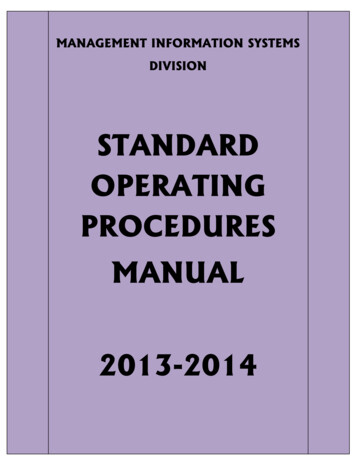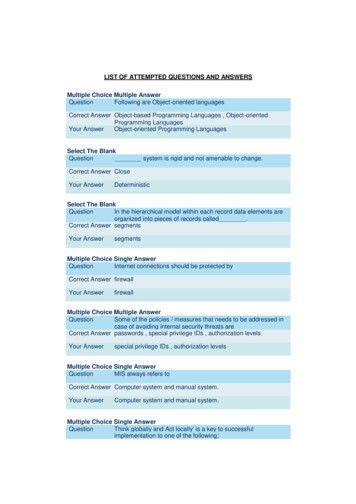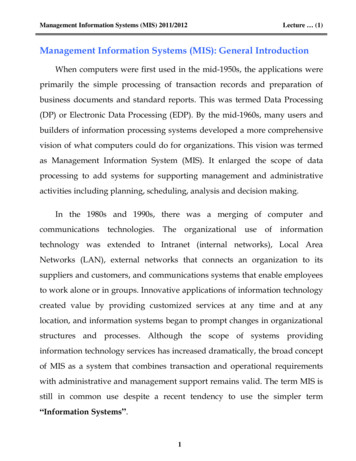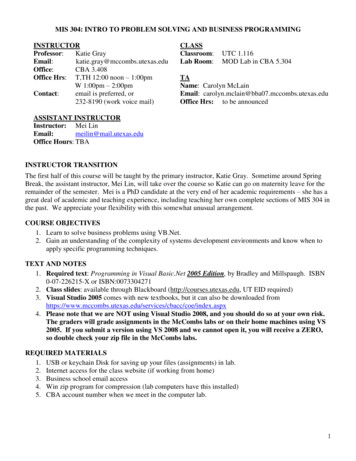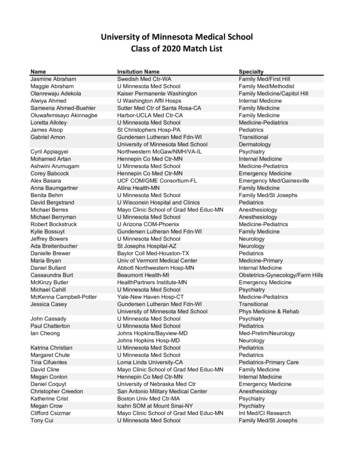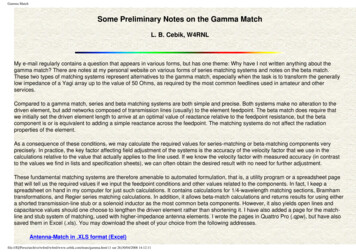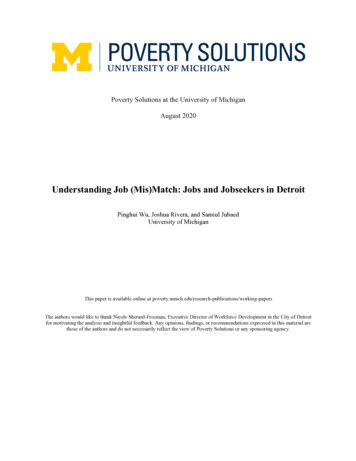
Transcription
Poverty Solutions at the University of MichiganAugust 2020Understanding Job (Mis)Match: Jobs and Jobseekers in DetroitPinghui Wu, Joshua Rivera, and Samiul JubaedUniversity of MichiganThis paper is available online at persThe authors would like to thank Nicole Sherard-Freeman, Executive Director of Workforce Development in the City of Detroitfor motivating the analysis and insightful feedback. Any opinions, findings, or recommendations expressed in this material arethose of the authors and do not necessarily reflect the view of Poverty Solutions or any sponsoring agency.
Understanding Job Match: Detroit at Work Jobs and Detroit JobseekersExecutive SummaryThe COVID-19 crisis has fundamentally changed Detroit’s labor and job markets, with the city’sunemployment rate currently estimated at 32% 1 and many businesses still shuttered. However, even priorto the pandemic, Detroit residents faced limited employment opportunities. This analysis examines theextent to which job opportunities available in Detroit and the tri-county area before the COVID-19 outbreakmatched the skills and attributes of Detroit residents. The results of this research can inform workforcetraining and barrier removal strategies, which will take on added importance during the period of economicrecovery. The following summarizes our main findings: Across several major cities in Michigan, Detroit had the lowest jobs-to-unemployed ratio, with just15 new job openings per month for every 100 unemployed residents in 2019. The ratio wassimilarly low in the tri-county area (Wayne, Macomb, Oakland), with only 21 new job openingsper month per 100 unemployed Tri-County residents. This suggests that job competition wassignificant for unemployed Detroiters even if they were willing to travel a longer distance foremployment. Low demand for workers without a bachelor’s degree and those in lower-skill occupations drovethe low job-to-unemployed ratio in Detroit. While there were only eight new job openings permonth for every 100 unemployed Detroiters without a bachelor’s degree, there was one new jobopening available for every unemployed Detroiter with a bachelor’s degree. The uneven supply of and demand for low-skill work in the metro region was only in part a resultof spatial mismatch. While improvements in transportation are needed to better facilitate matches,the region also needs to increase the total number of job opportunities. The digital knowledge gap (ability to use a computer) may prevent 45% of unemployed Detroitersfrom accessing 72% of opportunities in the city of Detroit and 66% of the job openings in the tricounty area 2. Driver’s license and auto insurance requirements may prevent 22% of unemployed Detroitresidents from 25% of the job openings in both the city and in the tri-county area. State occupational licenses could prevent nearly all unemployed Detroiters from 27% of the jobopenings in the city and 25% of the job openings in the tri-county area. Physical activities such as walking or standing may prevent 5% of the unemployed Detroiters from39% of the job opportunities in the city and 45% of job postings in the tri-county area. Furthermore,one-quarter of the labor force dropouts in Detroit (not working and not seeking employment either)have reported physical disability, and the high physical demand of available jobs may deter themfrom re-entering the labor force altogether.1Based on the estimation provided by the Local Area Unemployment Statistics (LAUS) program, US Bureau ofLabor Statistics for June, 2020.2The number of jobs for Detroiters throughout this study was obtained through the Detroit at Work website, whichincluded both jobs in the city of Detroit and in its neighboring ZIP codes.Page 2 of 12
Understanding Job Match: Detroit at Work Jobs and Detroit JobseekersBackgroundAnalyzing the opportunities for Detroit’s unemployed residentsOver the last 10 years, the economic recovery in Detroit has been significant, with substantial job growthup until the COVID-19 crisis. However, challenges in matching workers with jobs were still present in thelocal labor market. Detroit had the highest non-working adult population share of any large city in the U.S.This was partially attributable to the lower educational attainment in the city than the national average. Asa result, many residents lacked the skills needed to gain employment in high-skilled, higher-payingindustries (Corporation for a Skilled Workforce, 2015). Furthermore, disability, lack of transportation, andcriminal records created a set of intersecting barriers to employment (Holzer & Rivera, 2019). These issuesadded to historical trends that had long weakened Detroit’s labor market, such as racial segregation and thecollapse of the manufacturing sector in the region. In sum, even before the COVID-19 crisis, Detroit’sunemployed residents faced a complex set of challenges in accessing employment. 3Fortunately, by most accounts, the regional economy was strong prior to the COVID-19 crisis, and it ispossible that the economic growth bolstered the opportunity for unemployed individuals to find work(Burton et al., 2020). To understand the extent to which Detroit’s recovery had produced sufficient jobopportunities for its unemployed workers, we reviewed online job postings through the Detroit at Work andPure Michigan Talent Connect websites and compared the job requirements listed in those postings to thedemographic characteristics of the unemployed residents in Detroit and the tri-county area 4. Online jobpostings have become the primary way in which employers advertise and job seekers learn about new jobs(Maurer, 2016; Ross & Slovensky, 2012), making these posts a critical source of data to help us understandthe opportunities and challenges facing Detroit’s labor market.Specifically, we focus on three primary pre-employment screening areas that might prevent an unemployedworker from applying for or obtaining a job: skills, perceived risk, and mobility. Skills screening involvesemployers filtering their selection of candidates by educational attainment, existing skill sets, or prior workexperience. Many employers also screen candidates for perceived risks, including criminal convictions anddrug use. Finally, employers may screen for the mobility of applicants, such as by requiring a driver’slicense or auto insurance.DataThe job posting data used in the analysis were retrieved from Pure Michigan Talent Connect (PMTC) andDetroit at Work (D@W) via the Department of Technology, Management and Budget (DTMB) inMichigan. The D@W job posting data is a subset of the PMTC job postings for jobs located in Detroit andits neighboring ZIP code areas. Throughout the analysis, we used the PMTC job postings data for analysison the tri-county area and the D@W data for analysis on Detroit. The study sample consists of the universeof jobs posted on PMTC and D@W between Jan. 1, 2019, and Dec. 31, 2019. To supplement the jobdescription from the original job postings, we used the Standard Occupation Classification (SOC) code foreach job posting to obtain detailed occupation-specific skill requirements from the O*NET database. Tocompare the job requirement to worker demographics, we used the 2017 American Community Survey(ACS) and the 2016-2019 Current Population Survey (CPS) to estimate the educational attainment,occupation (based on the most recent work activities), and other demographic characteristics of theunemployed workers in the study area.This analysis only focuses on unemployed Detroit residents as they are by definition looking for work. If we included those outof the labor force the number of work-eligible adults is much larger.4 Detroit at Work is the City of Detroit’s one-stop resource for employment and training opportunities. Pure Michigan TalentConnect is the State of Michigan’s employment resource site.3Page 3 of 12
Understanding Job Match: Detroit at Work Jobs and Detroit JobseekersResultsHow did the number of job postings compare to the number of unemployed in Detroit?Detroit and its surrounding areas had the lowest jobs-to-unemployed ratio among major Michigan cities.Detroit had just 15 new job openings per month for every 100 unemployed Detroiters (jobs-tounemployment ratio of 15%) in 2019, whereas in Dearborn, Ann Arbor, Grand Rapids, Kalamazoo,Lansing, and Saginaw, there was at least one new job opening for every two unemployed workers eachmonth (a ratio of over 50%).If we include jobs in Detroit’s surrounding suburbs that are accessible through the D@W job site, the ratiofor Detroit’s unemployed workers increases to 23% 5. Alternatively, if we look at the tri-county area(Wayne, Macomb, and Oakland), where many Detroiters commute for work, the ratio is 21% 6. Whilethese ratios are slightly higher than for the city alone, they are still significantly lower than other Michigancities, suggesting that unemployed workers in Detroit face stiffer competition for job opportunities thanresidents in other Michigan cities, even if they are willing to travel a longer distance for employment. 7Table 1 - Job-to-Unemployed Ratio in Select Michigan Cities: 2019 Monthly Average# of jobs# n1,4621,3171.11Ann Arbor1,6561,5651.06Grand 422,1700.15-D@W job posting5,201N/A0.23Tri-county area17,55583,3920.21CityKalamazooSource: DTMB (2019) Pure Michigan Talent Connect Job Postings, BLS Local AreaUnemployment Statistics database (2019)The ratio shown here does not account for the unemployed population in these surrounding areas and is therefore an overestimate of the actual jobs-to-unemployed ratio for Detroit city and its bordering zipcodes.567The ratio reflects all unemployed individuals and job opportunities in the tri-county region.We did not generate metro estimates for the other cities referenced.Page 4 of 12
Understanding Job Match: Detroit at Work Jobs and Detroit JobseekersHow do the skills and attributes of unemployed Detroiters match with the requirements ofavailable jobs?First, the low jobs-to-unemployed ratio was partly driven by uneven supply and demand for lower-skilljobs. Table 2 compares the skill requirement of jobs and the skill attainment of unemployed Detroiters 8.The results show the low jobs-to-unemployed ratio in Detroit was driven by low demand for workerswithout a bachelor’s degree and those in lower-skill occupations.The jobs-to-unemployed ratio was 5% for high school dropouts, 8% for workers with a high schooldiploma or some college education, 28% for workers with an associate degree, and 100% for workerswith a bachelor’s degree or above. For clarity, this means that for every 100 unemployed Detroiters with ahigh school diploma, there were only eight new jobs per month that listed a high school diploma as theminimum education requirement. The ratios for those with more education may be higher than reportedhere, as an individual with more education may be qualified for a job that requires less education. Forexample, an associate degree holder may be qualified for positions in which the minimum educationrequired is a high school diploma. However, this would also mean that the individual would not becapturing the wage premium she would hope to have earned through obtaining a postsecondarycredential. It should also be noted that the high ratio for those with a bachelor’s degree may be artificiallyhigh, as jobs requiring more education may attract workers from across the region to a greater degree thanlower-skill work.Nevertheless, the higher jobs-to-unemployed ratio for workers with a bachelor’s degree suggests collegeeducation can improve the job-finding rate for a worker. The improvement, however, is conditional on theconferral of a degree and is very limited for workers with only an associate degree. 9Reflecting the low ratios for those with less education, we also see a low jobs-to-unemployed ratio inoccupations with lower entry barriers, such as those in the low-wage service sector (food services, buildingand ground maintenance, personal services), sales and administrative jobs, and blue-collar jobs (production,construction, and transportation). Detroit has an overwhelming excess supply of unemployed residentswhose most recent work experience was in lower-skill, entry-level occupations, compared with the numberof available jobs in these areas. Moreover, nearly one-quarter of unemployed workers reported nooccupation affiliation because they did not have work experience in the last five years. These workers arelikely looking for jobs in low-skill occupations as well, further aggravating the uneven supply and demandin these occupation categories.Indeed, 58% of unemployed Detroit residents have been unemployed for more than one year and 24% forover five years. Both figures are 50% higher than the state-level averages. Research has shown that theprobability of finding a job decreases steadily as the length of unemployment increases due to skilldeterioration and employer discrimination (Krueger et al. 2014). The longer unemployment length thus putsthese workers at a distinct disadvantage in the labor market.The number of unemployed Detroiters by skill attainment is obtained from the American Community Survey (2017) whichreports a higher unemployment number of than other official surveys. The jobs-to-unemployed ratios reported here are thereforedownward biased in their absolute value and are best used for comparative purposes.9 For this reason, we have combined workers with some college education with high school graduates in the analysis.8Page 5 of 12
Understanding Job Match: Detroit at Work Jobs and Detroit JobseekersTable 2 - Skill Requirements of Jobs vs. Skill Attainment of Unemployed DetroitersMonthly JobPostings(D@W 2019)Unemployed Detroitresidents(ACS 2017)Jobs-toUnemployedRatio# of jobs%# ome college/vocational training1042%12,27032%Associate AN/AProduction1573%4,33911%4%Construction, installation, and transportation4469%5,61815%8%Food, building Maintenance, and personal careservices3547%7,55920%5%Sales and administrative70714%7,72220%9%Health care support2495%9953%25%Management and business86817%5131%169%Computer, engineering and science97019%6932%140%Health care76415%2721%281%Others3948%1,6364%24%Occupation missing/no work experience in the lastfive years2926%9,16224%N/ABY EDUCATIONLess than high schoolHigh school diploma or GEDBachelor’s degree or aboveMissing information5%8%BY OCCUPATIONSource: DTMB (2019) Pure Michigan Talent Connect Job Postings; American Community Survey (2017) Public UseMicrodataSecond, the uneven supply and demand is in part a result of a spatial mismatch in skill supply and demandin the tri-county area (Wayne, Macomb, Oakland). Table 3 compares the skill requirement of jobs and theskill attainment of unemployed residents in the tri-county area. For the tri-county area as a whole, the jobsto-unemployed ratios are more equalized across the skill groups. Together with the results from Table 2,the numbers suggest there is a spatial mismatch in skill supply and demand within the tri-county area. Whilemost lower-skill jobs are located outside of the city of Detroit, unemployed workers with lower skillattainment tend to reside within the city. On the contrary, higher-skill jobs are more concentrated in Detroit,while unemployed workers with higher skill attainment tend to live outside of the city.The finding suggests transportation between Detroit and the rest of the tri-county area is essential forworkers with lower skill attainment to access suitable job opportunities in the area. However, it is alsoPage 6 of 12
Understanding Job Match: Detroit at Work Jobs and Detroit Jobseekersworth noting that the overall jobs-to-unemployed ratio is very low for the tri-county area compared to othermajor Michigan cities. Therefore, an increase in the total number of job opportunities and improvements intransportation are equally critical in facilitating job matches for the unemployed workers in the area.Table 3 - Skill Requirements of Jobs vs. Skill Attainment of Unemployed Tri-County ResidentsMonthly JobPostings(PMTC 2019)Unemployed Tri-CountyResidents(ACS 2017)Jobs-toUnemployed Ratio# of jobs%# of residents(18-64)%Less than high school2,51314%20,47518%High school diploma or GED7,25141%39,05434%3592%31,51327%Associate degree1,5479%6,8946%22%Bachelor’s degree or 1837%9,5288%12%Construction, installation, andtransportation1,54015,83114%10%Food, building Maintenance, andpersonal care services1,34721,56319%6%Sales and administrative2,96217%25,99422%11%Health care support1,0316%2,1392%48%Management and business2,18712%5,5925%39%Computer, engineering, and science2,90817%3,8543%75%Health pation missing/no work experiencein the last five years1,07720%N/ABY EDUCATIONSome college/vocational trainingMissing information12%11%BY OCCUPATION9%8%6%23,135Source: DTMB (2019) Pure Michigan Talent Connect Job Postings; American Community Survey (2017) PublicUse MicrodataPage 7 of 12
Understanding Job Match: Detroit at Work Jobs and Detroit JobseekersThird, large shares of entry-level jobs screen candidates on skills, perceived risk, and their mobility. Experience, education, occupational license, and computer knowledge requirements are common.In Table 5, we show that education and skills matter, with nearly 7 in 10 job openings on Detroitat Work’s website requiring more than one year of work experience and over half requiring morethan high school education. Occupational licenses are also important, with 27% of job postingsrequiring one, a number that matches national estimates. Finally, the digital economy has arrivedin Detroit, with 72% of postings requiring knowledge of how to operate a computer. Job postings do not commonly mention drug screening and background checks. Of all availablejobs, only 11% explicitly stated they perform a drug screen and 5% stated they conduct a criminalbackground check. Those shares get higher when just looking at jobs requiring a high schooleducation or less, which is our proxy for entry-level jobs. For example, we find 16% of entry-leveljobs require drug screening. Given that research conducted nationally finds nearly half of workers(48%) reporting some form of drug screening at their place of employment (Engber, 2015), it islikely that more employers do drug screen and conduct background checks but do not explicitlymention these practices in their job postings. Mobility matters in Detroit. 18% of all job openings in Detroit require a driver’s license. Thisnumber rises to 20% for entry-level positions. Similarly, 15% of entry-level jobs require workersto have auto insurance for work purposes, despite the fact that an estimated 60% of Detroiters donot have auto insurance (Reindl, 2017) and those that do pay an exorbitant average premium ofaround 5,400 a year (Cooney et al., 2019). A majority of these entry-level jobs also requireextensive physical mobility, with 55% of positions involving a significant amount of walking orstanding.Table 4 - Prevalence of pre-employment screening in DetroitAll Job OpeningsBarrierJobs Requiring HS or Less s more than 1 year work experience67%59%44%38%Requires more than high school education54%44%--Requires an occupational license27%25%17%14%Requires computer knowledge72%66%49%46%Requires criminal background check5%8%9%11%Requires drug screening11%11%16%14%Requires walking/standing39%45%55%60%Requires driver's license18%18%20%20%Requires auto al Monthly New Job PositionsSource: DTMB (2019) Pure Michigan Talent Co
opportunities for its unemployed workers, we reviewed online job postings through the Detroit at Work and Pure Michigan Talent Connect websites and compared the job requirements listed in those postings to the demographic characteristics of the ed unemployresi


